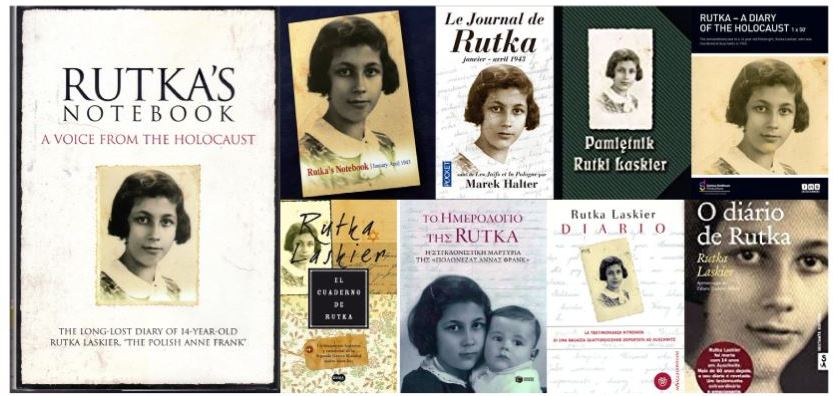Rutka Laskier’s Birth Record Finally Located

On what would have been the 89th Birthday of Rutka Laskier – June 12, 2018, an announcement by Jewish Records Poland-Indexing, Inc. and The Bedzin-Sosnowiec-Zawiercie Area Research Society about newly discovered information on Rutka Laskier’s family history.
Rutka Laskier was a 13 year old Jewish girl when she kept a diary chronicling the three months of her life in Bedzin, Poland, while under Nazi German occupation — from January 19, 1943 to April 24, 1943. Her dairy was published for first time in 2006, drawing comparisons to the diary of Anne Frank instantly. In fact, Anne Frank was born on the very same day and year as Rutka Laskier — June 29, 1929. Rutka’s diary has since been released in numerous translations.
The Diary
The diary begins on January 19, 1943, with the entry “I cannot grasp that it is already 1943, four years since this hell began.” One month later, on February 20, 1943, she writes: “I have a feeling that I am writing for the last time. There is an Aktion in town. I’m not allowed to go out and I’m going crazy, imprisoned in my own house| For a few days, something’s in the air| The town is breathlessly waiting in anticipation, and this anticipation is the worst of all. I wish it would end already! This torment; this is hell. I try to escape from these thoughts, of the next day, but they keep haunting me like nagging flies”
Rutka’s Origins?
Ever since her diary was published, biographers and historians have stated that Rutka Laskier was born in Danzig now Gdansk, a Baltic port city in northern Poland. However, experienced genealogists know that errors often occur in documenting Polish-Jewish family history — both in the reading of records or false assumptions where records are not available. Since the Gdansk birth records do not reveal an entry for Rutka’s birth, some have raised a question as to the validity of the assumption that she was born there.
This led Stanley Diamond, the Executive Director of Jewish Records Indexing-Poland and Jeffrey Cymbler, JRI-Poland’s Bedzin Town Leader and Founder of the Bedzin-Sosnowiec-Zawiercie Area Research Society (BSZARS), to ponder the assumptions concerning Rutka Laskier’s place of birth and to look for answers.
Holocaust survivors and their families, as well as pre-war Jewish immigrants from Poland and their descendants, may be unaware that a remarkable number of Jewish records of Poland have survived the upheavals of history and the ravages of war. JRI-Poland has created indices/extractions to more than 5 million Jewish birth, marriage and death records from more than 600 towns in current and former territories of Poland. In addition to vital records, the JRI-Poland online database includes other types of records such as Books of Residents, censuses, army draft lists, school records, cemetery burials, Polish passports, ghetto death records, birth, marriage and death announcements in Polish newspapers and post-war court and legal announcements in official newspapers. The data varies widely by town or region. JRI-Poland’s records for the Bedzin area are among the richest of its holdings. Jeff Cymbler decided to renew the research of Rutka Laskier’s origins. JRI-Poland and BSZARS are now pleased to announce the results of their findings.
Rutka’s Actual Birthdate and Birthplace
One of JRI-Poland’s expert researchers in Poland, Jakub Czuprynski, located the Books of Residents for Bedzin in the Katowice Branch of the Polish State Archives. These huge books span the mid-19th century to 1931 and are over 10,000 pages. The Books of Residents are a treasure chest of information for family historians. In these books, Jacob found the page with the Laskier family on page 9768. Here was the surprise. The Book of Residents revealed that Rutka was not born in Gdansk. But according to the 1929 entry in the book, Rutka was born in Krakow!
Determined to locate Rutka’s actual birth record, with the permission of Rutka’s half-sister, Jakub was asked to search the Krakow city registry for Rutka’s actual birth certificate. Jakub found Rutka’s birth record in Krakow. The birth record states that Rutka was born on June 12, 1929. From the birth record we learned that Rutka’s mother’s maiden name was Hampel. It also states that Rutka was given her name by her parents in the Bedzin synagogue, two days later, on June 14, 1929.
Jewish girls are traditionally given their names in the synagogue on the Sabbath when the Torah is read. However, Rutka received her name on a Friday when the Torah is usually not read in the synagogue. However, it was quickly determined that Friday June 14, 1929 was a Jewish holiday. It was Shavuot — the Pentecost — when according to Jewish tradition, Moses received the ten commandments on Mt. Sinai. Research into Rutka’s family tree did not reveal any ancestors of Rutka who bore the name Rutka. Therefore, Rutka’s sister, Zahava, is convinced that Rutka was given the name Rut (Ruth) because she was named on Shavuot — the holiday when Jews traditionally read the Book of Ruth in addition to the torah in the synagogue.
Rutka’s Family’s Address and Business
Research into the “1938 Directory of Manufacturers of Poland” and the 1939 Telephone Book for Bedzin located the grocery merchant firm of A. Hampel & N. Goldsobel as having been incorporated in 1916. Jakob Laskier was one of the members of the board of directors. Another was Abram Chil Hampel, Rutka’s maternal grandfather. Among the products that the company dealt in were rice, sugar, sardines and other food products. The company also had branches in the neighboring towns of Sosnowiec and Dabrowa Gornicza. The phone number was 71058.
The 1939 census of the Jews in Bedzin — renamed Bendsburg by the Germans — was found in the Jewish Historical Institute in Warsaw. In it, the entry for Rutka and her family appears on page 283. The census record lists Ruth (born on June 12, 1929), her father, Jakob (born on August 7, 1900), mother Dwojra (Deborah) (born September 13, 1904) and her little brother, Joachim, nicknamed Henius (born August 3, 1937). The family lived in an apartment in the center of Bedzin on 4 Sw. Jana Street which is now called Moniuszki Street.
Rutka’s Grandfather’s Grave
In early 1940, Rutka’s grandfather, David Laskier, died in Bedzin. In his book on the Bedzin cemetery, “The Cemetery of the Jewish Communities of Bedzin and Czeladz Poland,” Jeff documented each of the over 3000 tombstones in the cemetery. The database and photos of each of the tombstones are researchable on JRI-Poland”s website. Jeff located the tombstone in the cemetery which was erected after the war to remember Rutka”s grandfather, David Laskier, and the other family members who met their tragic deaths during the Nazi German occupation.
From January 19 to April 24, 1943, Rutka kept a diary in an ordinary school notebook. In it, she discussed atrocities she witnessed committed by the Nazis, and described daily life in Bedzin.
Laskier Family Deportation to Auschwitz
In April 1943, Rutka and her family were sent to the ghetto in the Kamionka district of Bedzin. On August 5, 1943, Rutka and her family were deported with her family to Auschwitz-Birkenau where she met her death in a gas chamber. Her father, Jakob became prisoner 135519. Jakob was later sent to Sachsennhausen Concentration Camp. Rutka’s Auschwitz number was probably somewhere between 52572 to 53820.
Although Rutka’s uncles, Israel and Fiszel Laskier, and a cousin Michal Laskier, had South American passports ordered for them by Polish diplomats in Bern, Switzerland, in cooperation with Jewish organizations in Bern and Lausanne, they did not survive. Jeff and BSZARS are currently working with the Polish Ambassador in Bern, Switzerland, and the Honorary Polish Consul in Zurich to fully document the story of hundreds of Bedzin area Jews who were assisted by the Polish diplomats during the Holocaust in attempts to obtain false South American passports.
Revelation of the Diary
In 1943, while writing the diary, Rutka shared it with Stanislawa Sapilska, a then 21-year-old Polish woman, who Rutka had befriended. Rutka gradually came to realize she would not survive, and, realizing the importance of her diary as a document of what had happened to the Jewish population of Bedzin, asked Sapilska to help her hide the diary. After the ghetto was evacuated and all its inhabitants sent to the death camp, Sapilska returned to the house and retrieved the diary. She kept it in her home library for 63 years and did not share it with anyone but members of her immediate family. In 2005, Sapilska told Adam Szydlowksi, an historian in Bedzin, about the dairy. Recognizing the importance of the diary to Holocaust memory, Adam arranged to have the diary published.
Rutka’s Half-Sister, Zahava, Is Honored
Rutka’s father, Jacob, was the only member of the Laskier family to survive. Eventually he emigrated to Palestine, remarried and had another daughter, Zahava, named after Jabob’s mother, Golda.
JRI-Poland and BSZARS hosted an event in NY several years ago, at which time, Stanley Diamond and Jeff Cymbler had the honor to present Zahava with this new historical information that they uncovered in connection with Rutka.
Rutka’s Final Words
One of Rutka’s final entries says “If only I could say, it’s over, you die only once… But I can’t, because despite all these atrocities, I want to live, and wait for the following day.”
Happy Birthday Rutka — Your words live on and your memory is not forgotten!


